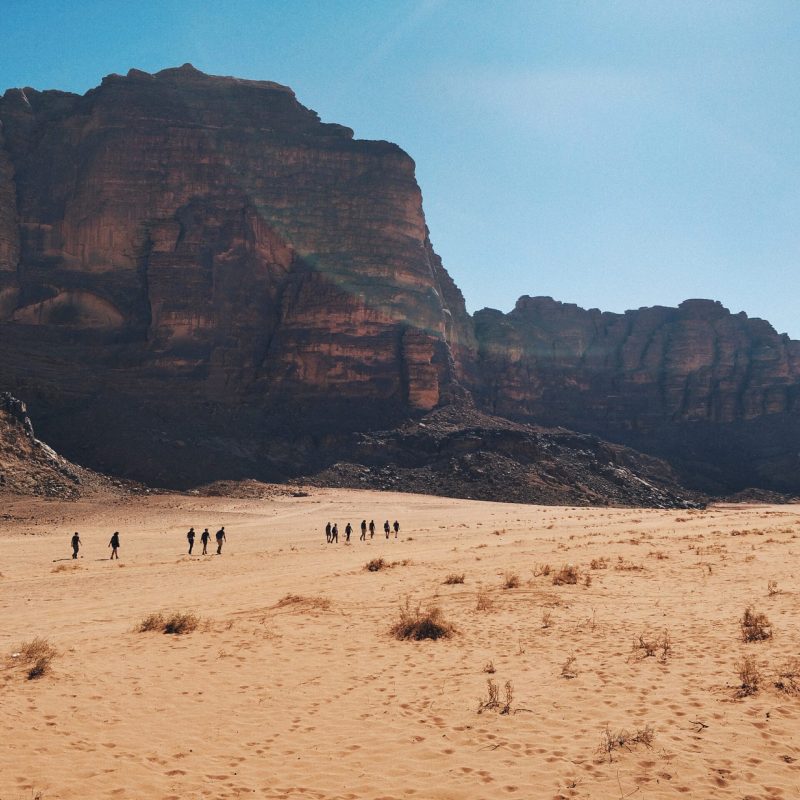
It’s a wonder that Jordan endures as the heart of tranquility in the Middle East. Looking at a map you see that the country borders many conflict nations — from Syria to the north, Saudi Arabia, Iraq, and Egypt. Why it is able to exist so calmly is a good question.
Videos by TravelAwaits
Perhaps the magic lies in the questionable luck of an economy bereft of oil reserves and the undeniable blessing of a people who have traditionally welcomed strangers, from the Bedouins to today’s hospitality industry. It’s an alchemy that leads to wonderful experiences, kindly guides, gorgeous accommodations, and well-preserved natural beauty. The pity is that many travelers land in Amman, stop in Petra for a night or two, and perhaps scoot into the desert of Wadi Rum for a day before flying off to other destinations. Such a quick trip misses many of the treasures patiently waiting for discovery across the country.
So let’s take a look at the other side of Jordan — beyond the most popular tourist spots — and go off the beaten path.
Bedouin Hospitality
Today Jordanians still speak kindly of Lawrence of Arabia, even though his efforts, made famous by T.E. Lawrence and Hollywood, brought doom to independence fighters a century ago. Jordanians keep those wounds to themselves and look toward tomorrow, the next decade or eon. Having a culture built over thousands of years may have tempered their outlook beyond immediate discomforts.
Now in Wadi Rum, Jordanians set their deep experiences into creating fantastical, comfortable desert camps and get-aways. Lawrence described the landscape as “Vast, echoing and God-Like.” That’s certainly true in the deep canyon passes near the “Seven Pillars of Wisdom” and in the thundering silence within Bedouin camps.

Camel ride in Wadi Rum, Photo: Elaine J Masters
Nomadic Bedouins live simply. They tend their sheep and set up tents throughout the country, even along modern highways in Amman. Bedouin hospitality is not just an exotic phrase. Their meagre homes are open to strangers who are invited in for tea or to sample Cardamom flavored coffee. These tours can be arranged in Wadi Feynan where visitors are welcome to join guides from Feynan Eco Lodge.
Feynan, Renowned Eco Lodge
Hailed as one of the top fifty eco lodges in the World by National Geographic magazine, Feynan is candlelit, solar powered for hot water, and refillable pottery water jugs are part of the in-room amenities. In the evenings, all are invited to stargaze from the rooftop where the Lodge’s high definition telescope reigns.
Meals are vegetarian buffets with seating available under the wide trees of the canyon patio, or at tables in the inner courtyard. Bedouin guides who work in the lodge welcome guests on a short walk into the world of their people. At sunset, drink tea served traditionally on a rise overlooking the desert. In the mornings, enter the village. A school building offers an anchor for the nomadic families who herd in the area before retreating from scorching heat to the high country in the summers. Guests may join a family for tea and have a conversation through the guide.
Aqaba is a different type of playland. The sleek resort city was a supply base for the Arab Revolt but remains a commerce center and metropolitan port today. Five-star luxury hotels like the Kempinski Aqaba sit close to the Red Sea and take advantage of wide views across into Egypt. Dive boats and pleasure craft charters sail into shallow bays full of tropical fish and abundant reefs.

Quiet moments in Feynan Lodge. Photo: Elaine J Masters
Cathedrals and calls to prayer
While Muslim calls to prayer echo across the country, Christian Holy Sites are preserved in Jordan as well. Bethany Beyond Jordan, where the Apostle John baptized Jesus, is a destination for religious pilgrims and international visitors. Mount Nebo is another popular pilgrimage site, and the Basilica is filled with mosaic art commemorating Moses’ resting place. This is where Moses, according to the Bible, looked across the Jordan Valley to the Dead Sea and beyond to the rooftops of Jerusalem. Nearby, the city of Madaba is a Christian center renowned for mosaic art and traditional crafts. Inside the Greek Orthodox Church of St. George the walls are layered with paintings and illustrative stonework. A Byzantine mosaic map set into the floor is a vivid outline of other holy sites in the region. The church is also renowned as a center for miracles.
In the hillside town of Umm Qais, locals are reviving the art of beekeeping and tend olive orchards. There are many home businesses and at one B&B, Beit Al Baraka, the House of Blessings, home tours can be booked. Visit a basket maker, cheese makers or take a cooking class to learn about pickling and bread baking.

Inside the Mt. Nebo Basilica. Photo: Elaine Masters
Amman, Gadara, Jerash, the city of a thousand columns
Jordan preserves architectural reminders of its conquerors and the countryside is peppered with wonders that rival those in Rome.
In Amman, the Greek Amphitheater and the Citadel are popular stops. Just outside the village of Umm Qais, the Decapolis City of Gadara has preserved long avenues of stone buildings as well as the ancient plumbing system which brought water up the mountain to fill fountains, baths, and pools. Towering columns cast shadows across the wide avenues throughout the ancient city of Jerash. The Romans built a Hippodrome for chariot racing in about 220 AD. Today, Jordanians hold concerts inside the stone ‘circus’ space that once held over seventeen thousand spectators. Carved stones and decorated columns still awe visitors. Strains of music often echo as bands of musicians take advantage of the acoustics inside the steep amphitheater.
Their timeless notes and warm smiles are only earned through the effort it takes to explore Jordan’s lesser-known sites. But that effort is well worth your trouble.

Jerash. Photo: Elaine J Masters
We hope this article convinced you there’s more to see in Jordan than just Petra. If nothing else, it’s always enriching to learn more about other cultures — especially when those cultures are noted for hospitality!
